Madarasz’s Tiger Parrot
Also known as:
Madarasz's Ground Parrot, Plain-breasted Little Parrot
Also known as:
Madarasz's Ground Parrot, Plain-breasted Little Parrot
DID YOU KNOW?
The Psittacella group of parrots are coloured like no others in the parrot world; their prominently barred plumage is the reason for the “tiger” name.

Psittacella

madaraszi
Size:
14 cm (5.5 in)
Weight:
34-44 g (1.2-1.5 oz)
Subspecies including nominate:
four: P.m. madaraszi, P.m. huonensis, P.m. hallstromi, P.m. major
Colour Adult:
P.m. madaraszi: Male-olive/brown head; centres of feathers of crown to hindneck yellow, giving mottled or speckled appearance; throat and lower cheeks have paler yellow spotting; olive/brown wash on upper breast; red undertail coverts; green upperparts with narrow barring of green/yellow and black; green tail. Beak blue/grey tipped with white. Eye brown/red. Female- blue wash on forehead; orange wash on occiput, nape and hindneck, with black barring; yellow/green rump and lower back barred with black. Eye red.
P.m. huonensis: Male-crown more yellow than that of madaraszi. Female-differs from madaraszi in that the orange on occiput to hindneck is absent, and less black barring on occiput.
P.m. hallstromi: Male-in general plumage is darker than madaraszi; head darker brown, the feathers more thinly centred yellow. Female- as in madaraszi, but more strong wash of red/orange on nape to hindneck and more widely barred with black.
P.m. major: Both adults as in madaraszi, but larger.
Colour Juvenile:
P.m. madaraszi: As in adult female, but barring on nape and hindneck paler and less extensive; faint yellow and brown barring on breast. Eye brown/yellow.
P.m. huonensis: As in adult female.
P.m. hallstromi: As in adult female.
Call:
Calls are described as high-pitched and upslurred.
More Information:
Content Sources:
CITES
BirdLife International
Cornell Lab of Ornithology/Birds of the World
Parrots: A Guide to Parrots of the World, Juniper and Parr, 1998
Parrots of the World, Forshaw, 2006. 2010 edition
Lexicon of Parrots, Thomas Arndt.
Captive Status:
Not found in captivity.
Longevity:
—
Housing:
—
Diet:
—
Enrichment:
—
Nest Box Size:
—
Clutch Size:
Not recorded.
Fledging Age:
—
Hatch Weight:
—
Peak Weight:
—
Weaning Weight:
—
World Population:
Unknown, but described as uncommon. Decreasing.
IUCN Red List Status:
Least Concern
CITES Listing:
Appendix II
Threat Summary:
Not globally threatened. Is uncommon, perhaps due to its shy nature. Regularly recorded below Tari Gap, Papua New Guinea. This species is considered to have a medium dependency on forest habitat and tree cover is estimated to have declined by 2% within its range over the past 10 years. Therefore it is tentatively suspected that this may have led to a 1-19% decline in the species’ population size over the same period.
Range:
P.m. madaraszi: Mountains of SE Papua New Guinea, west in north to Mount Misim in south to Angabunga River.
P.m. huonensis: Mountains of Huon Peninsula, N Papua New Guinea.
P.m. hallstromi: Central Highlands, Papua New Guinea, west to Hindenburg Range, West Papua.
P.m. major: Weyland Mountains and northern slopes of Snow Mountains, West Papua.
Habitat:
Found from 1100-2500 m (3575-8200 ft) in forest, secondary growth forest and occasionally partly cleared areas, particularly Nothofagus sp. or beech forest.
Wild Diet:
Feeds on seeds, fruit, hard berries and leaf pulp; birds have also been seen feeding at the bases of arboreal ant plants.
Ecology and Behaviour:
Seen alone or in pairs foraging at different levels of the canopy. Have been observed in the company of Painted Parrots (Psittacella picta). Is quiet, slow-moving and inconspicuous, roosting in the lower canopy and stirring briefly at dusk to call.
Clutch and Egg Size:
Not recorded.
Breeding Season:
June-September.
Related Links:
—
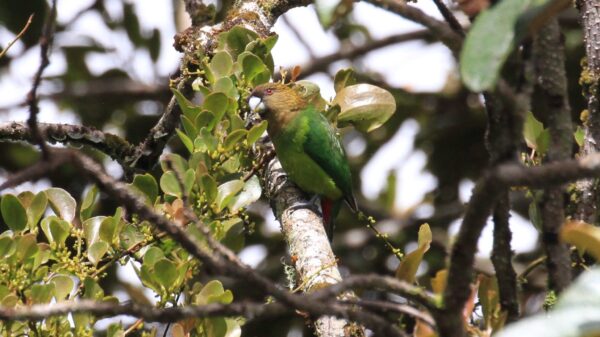
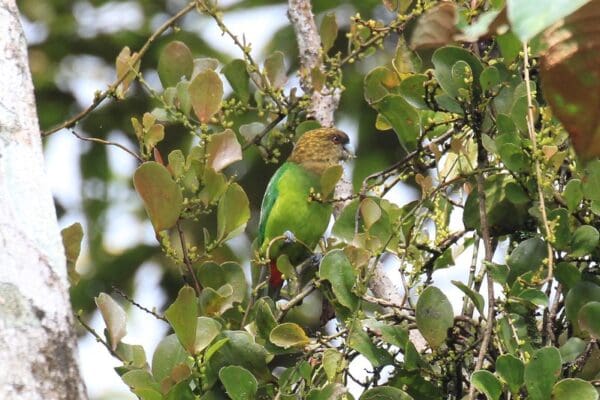
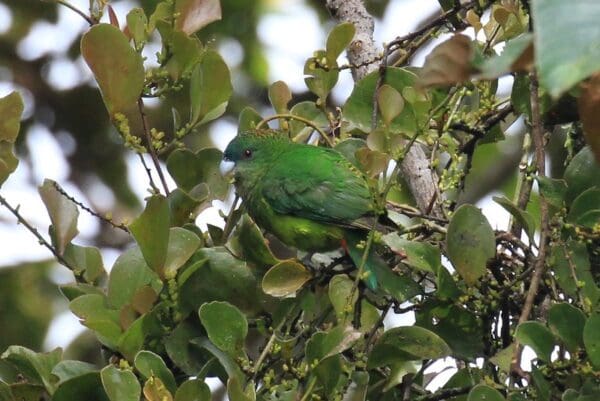
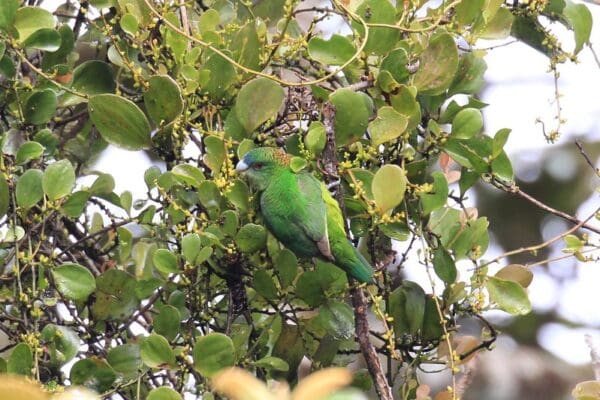
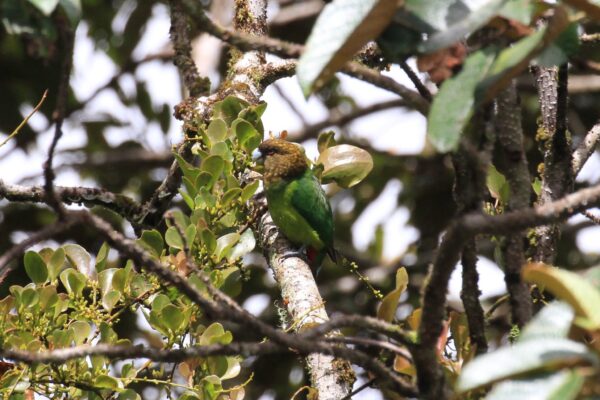
![© Charles Davies [CC BY-SA 2.0] via Flickr A wild male Madarasz's Tiger Parrot perches in a leafy tree](https://parrots.org/wp-content/uploads/1990/06/Madaraszs-Tiger-Parrot2-Charles-Davies-e1732122888204-100x100.jpg)
![© Charles Davies [CC BY-NC 2.0] via Flickr A wild male Madarasz's Tiger Parrot perches in a leafy tree](https://parrots.org/wp-content/uploads/2023/01/Madaraszs-Tiger-Parrot3-100x100.jpg)
![© Charles Davies [CC BY-NC 2.0] via Flickr A wild female Madarasz's Tiger Parrot perches in a leafy tree](https://parrots.org/wp-content/uploads/2023/01/Madaraszs-Tiger-Parrot2-100x100.jpg)
![© Charles Davies [CC BY-NC 2.0] via Flickr A wild female Madarasz's Tiger Parrot climbs among leafy branches](https://parrots.org/wp-content/uploads/2023/01/Madaraszs-Tiger-Parrot-100x100.jpg)
![© Charles Davies [CC BY-SA 2.0] via Flickr A wild male Madarasz's Tiger Parrot perches in a leafy tree](https://parrots.org/wp-content/uploads/1990/06/Madaraszs-Tiger-Parrot-Charles-Davies-100x100.jpg)